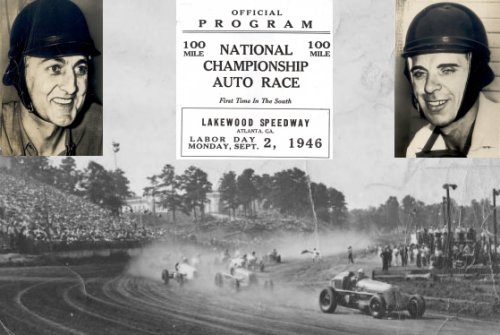
Labor Day, 1946 saw George Barringer (left) and George Robson (right) lose their lives in a AAA Indy car event at Lakewood Speedway in Atlanta.
By Brandon Reed
Posted in Feature Stories 8/27/09
It remains one of the most infamous days in Georgia racing history.
Labor Day, September 2, 1946. Lakewood Speedway in Atlanta played host to a AAA Indy Car race that featured open wheel hero Ted Horn, defending Indianapolis 500 winner George Robson and popular Texas wheelman George Barringer, along with eight other drivers, in a 100-mile event in the sweltering Georgia summer.
It was in the midst of a heat wave, and with temperatures reaching 100 degrees, these brave knights of the roaring road did battle at a track called the “Indianapolis of the South”.
With the air choked with thick plumes of dust from the Georgia red clay, Ted Horn appeared on his way to another win on the Atlanta mile.
But with just a few laps remaining, disaster struck. Four cars became entangled in a melee around the third turn. When the dust cleared, Robson and Barringer were dead. Horn was declared the winner, but it would later be stripped of the victory in a technical issue.
And a dark chapter in the history of Georgia automobile racing had been written.
There are aspects of many stories in automobile racing that have fixated certain fans throughout the years. For example, web site author Rex Dean has created an incredible site that thoroughly investigates the 1955 accident that took the life of two-time Indy 500 winner Bill Vukovich. Using film, still photos, published reports and eyewitness accounts, Dean has reconstructed the accident in meticulous fashion, finding incredible details others would have passed up.

The aftermath of the crash, with Robson's car on the left, Barringer's on the right. Photo courtesy Eddie Samples
For me, my fixation comes on the story of the Robson-Barringer accident at Lakewood Speedway in 1946. I first heard about the accident in passing while in college, when it was mentioned during a “This Day In History” segment on the History Channel.
Later, I would read Mike Bell’s well-researched story on George Barringer and the accident, which I consider to be one of the best works written on the subject (and which is also posted at this website). But after reading Bell’s story, I felt there was something more to the story. I researched other accounts of the accident, including wire copy from the day of the crash, but I never could find more than the same account, which always seemed short on detail.
The problem was that there had never been, that I could find, a first person account of the accident. All that was known were the generalities. Billy DeVore, suffering from a problem of some sort, was running slowly on the lower half of the track. Somehow, his car tangled with that of Robson, causing the crash that would also involve Barringer and Bud Bardowski.
Part of the problem was also that all of the journalists watching the race that day were in the press box high atop the grandstands on the other side of the track. With the dust created by the high powered Indy cars on the worn out Georgia clay, it was nearly impossible to see what had transpired on the 97th lap of the event. So it seemed we would never know more than the few facts we had, leaving me with a nagging feeling that the whole story would never be told.
Earlier this year, I began doing newspaper searches on Lakewood Speedway, in hopes of finding some long lost tidbits of information on the track for a story I was working on to launch this website.
That’s when I came across an item that changed the Robson-Barringer story, or at least suggested that there were errors in the wire report. That item started me on a journey that led me back to Lakewood, and eventually, to a person who saw that fateful crash play out right in front of him.
It started with a photo.
